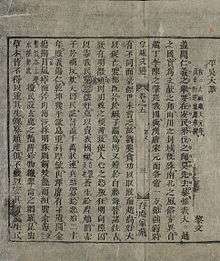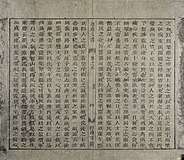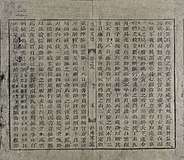Bình Ngô đại cáo
Bình Ngô đại cáo (literally: Great proclamation upon the pacification of the Wu[1]) was an announcement written by Nguyễn Trãi in 1428 after the order of Lê Lợi to proclaim the total pacification of the Ming Dynasty and affirm the independence of Đại Việt to its people.
| Bình Ngô đại cáo 平吳大誥 | |
|---|---|
 First page of Bình Ngô đại cáo | |
| Created | 1428 |
| Author(s) | Nguyễn Trãi |
| Purpose | To announce the total pacification of the Ming Dynasty and affirm the independence of Đại Việt |
Naming
Bình Ngô đại cáo literally means Great Proclamation upon the Pacification of the Wu in which Wu (吳, Ngô) was the ancestors's land (now Fengyang County, Anhui) of Zhu Yuanzhang, the founder of the Ming Dynasty. In 1356, Zhu Yuanzhang himself took the title Duke of Wu (吳國公) and later King of Wu (吳王, in Vietnamese: Ngô Vương). Therefore, one could reason that Nguyễn Trãi named his work Pacification of the Wu instead of Pacification of the Ming in order to subtly emphasize the victory of Đại Việt and the failure of the Ming Dynasty which was called by its origin's name Wu in the proclamation.[2] The second part of the name, đại cáo (大誥) is commonly understood as the denotement of its literary genre, a great edict (cáo), or the announcement's great scale (đại cáo). The former was the name of a chapter in the book Classic of History in which great edict was a special form of an edict. But during the time of the early Ming Dynasty, great edict was used by Hongwu Emperor for his official documents of imperial laws and thus became a symbol of power and authority of the Ming emperor. For this reason, there was an opinion that Nguyễn Trãi named his announcement đại cáo for the purpose of reversing the meaning of great edict from the symbol of Ming emperor to the representation of Đại Việt victory over his very own army.[2][3]
Background
We have at no time lacked heroes.[4]
In 1427, Lê Lợi led the Lam Sơn uprising to the ultimate victory over the Ming Dynasty which put an end to the Fourth Chinese domination in Vietnam. As a result, in 1428 Lê Lợi ordered Nguyễn Trãi to write an announcement for people in the country about the total pacification of the Ming Dynasty and the affirmation of the independence of Đại Việt.[7] From that demand, Nguyễn Trãi wrote Bình Ngô đại cáo which not only proclaimed the independence of the country but also claimed the equality of Đại Việt with China during the long history and expressed many own ideas of Nguyễn Trãi about the fairness, the role of people in history of the country and the way to win a war of independence.[8] Besides, Nguyễn Trãi used Bình Ngô đại cáo to prove the just cause of the Lam Sơn uprising and why Lê Lợi's army could drive out the Ming Dynasty with its policies of relying on people to fight against the invaders.[9] After it was announced, the proclamation was considered a success, while Nguyễn Trãi became one of the most crucial figures of the royal court after the coronation of Lê Lợi, now Lê Thái Tổ. However Nguyễn Trãi was finally executed in 1442 during the political struggle in the royal court and royal family of the early Lê Dynasty.[10][11] The earliest version of Bình Ngô đại cáo that remains today was found in the 1697 edition of Đại Việt sử ký toàn thư which was compiled by Ngô Sĩ Liên.[9]
Content
Bình Ngô đại cáo is an edict-like (Vietnamese: cáo) announcement written in the literary form of parallel constructions (văn biền ngẫu). The proclamation was divided in four parts:[9][12]
- The first part demonstrated the history of Đại Việt with its identity and tradition of fighting against Chinese dynasties for the purpose of independence and equal position as China.
- The second part denounced the conspiracy and truculent crime of the Ming Dynasty during their domination in Đại Việt when they enslaved the people and deprived resources of the country.
- The third part narrated the Lam Sơn uprising from the hard beginning to the final victories.
- The fourth part summarized the lesson from history and reaffirmed that righteousness would win.
Originally, Bình Ngô đại cáo was written in Hán tự,[7] it was translated into Vietnamese by several scholars such as Ngô Tất Tố, Bùi Kỷ or Trần Trọng Kim, the translated version by Trần Trọng Kim in his Việt Nam sử lược and the revised version by Bùi Kỷ are considered the more popular and included in the schoolbook in Vietnam.[2]
Significance
Bình Ngô đại cáo is considered the second declaration of independence of Vietnam after the poem Nam quốc sơn hà which was written by Lý Thường Kiệt in the early Lý Dynasty. The proclamation is highly appreciated not only for its value of propaganda and history but also for its fine literary quality which is praised as the "Incomparably powerful writing document" (Thiên cổ hùng văn) in the History of Vietnam.[7][9][15] With Bình Ngô đại cáo, Nguyễn Trãi asserted the obvious independence and equal status of Vietnam with China and more importantly, reckoned that independence could be achieved only when the rulers had concern for their people and made decision for the interest of the masses.[8][9] Today, Bình Ngô đại cáo is taught in both secondary (grades 6–9) and high school (grades 10–12) in Vietnam.[2]
References
Notes
- Anthony Reid, Kristine Alilunas-Rodgers (2001). Sojourners and settlers: histories of Southeast Asia and the Chinese. University of Hawaii Press. p. 102. ISBN 0-8248-2446-6.
- Nguyễn Đăng Na (2005). "Bình Ngô đại cáo: Một số vấn đề về chữ nghĩa". Hán Nôm Magazine (in Vietnamese). Hanoi: Institute of Hán Nôm (2/2005).
- Phạm Văn Khoái (2002). "Từ một số nhận xét của các nhà ngữ văn truyền thống về văn thể đến chương trình môn Hán văn Việt Nam". Hán Nôm Magazine (in Vietnamese). Hanoi: Institute of Hán Nôm (5/2002).
- Vietnamese: Tuy mạnh yếu có lúc khác nhau. Xong hào kiệt đời nào cũng có.
- Ngô Sĩ Liên 1993, pp. 354–359
- Translation from Marr, David G. (1980). Vietnamese Anticolonialism, 1885-1925. University of California Press. p. 7. ISBN 0-520-04277-8.
- Trần Trọng Kim 1971, p. 91
- Womack, Brantly (2006). China and Vietnam: the politics of asymmetry. Cambridge University Press. p. 130. ISBN 0-521-61834-7.
- "Bình Ngô đại cáo" (in Vietnamese). Từ điển Bách khoa toàn thư Việt Nam.
- Womack, Brantly (2006). China and Vietnam: the politics of asymmetry. Cambridge University Press. p. 132. ISBN 0-521-61834-7.
- Poisson, Emmanuel (2004). Mandarins et subalternes au nord du Viêt Nam: une bureaucratie à l'épreuve, 1820-1918 (in French). Maisonneuve & Larose. p. 160. ISBN 2-7068-1710-0.
- Tham Seong Chee 1981, pp. 310–312
- Vietnamese: Việc nhân nghĩa cốt ở yên dân. Quân điếu phạt trước lo trừ bạo.
- Translation from Tham Seong Chee 1981, p. 312
- Nguyễn Hữu Oanh (2002). "Sao Khuê tỏa sáng". Hán Nôm Magazine (in Vietnamese). Hanoi: Institute of Hán Nôm (4/2002).
Bibliography
- National Bureau for Historical Record (1998), Khâm định Việt sử Thông giám cương mục (in Vietnamese), Hanoi: Education Publishing HouseCS1 maint: ref=harv (link)
- Chapuis, Oscar (1995), A history of Vietnam: from Hong Bang to Tu Duc, Greenwood Publishing Group, ISBN 0-313-29622-7
- Ngô Sĩ Liên (1993), Đại Việt sử ký toàn thư (in Vietnamese) (Nội các quan bản ed.), Hanoi: Social Science Publishing HouseCS1 maint: ref=harv (link)
- Trần Trọng Kim (1971), Việt Nam sử lược (in Vietnamese), Saigon: Center for School MaterialsCS1 maint: ref=harv (link)
- Tham Seong Chee (1981), Essays on Literature and Society in Southeast Asia: Political and Sociological, NUS Press, ISBN 9971-69-036-5CS1 maint: ref=harv (link)


